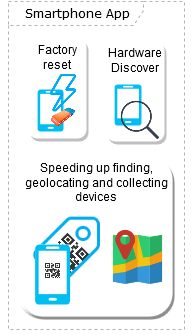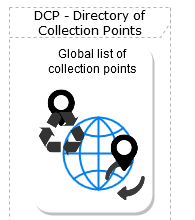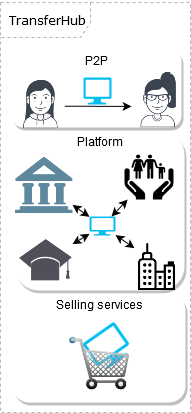OPEN SOURCE PLATFORM
The eReuse.org platform defines a distributed system, instantiated by multiple organizations and implemented as software services, tools and data repositories.
Circular economies are particularly relevant in the context of digital devices or electric and electronic equipment (EEE). Many digital devices built using scarce and potentially toxic materials have a too-short life, instead of being repaired or reused. In addition, informal recycling of electronics in the developed and developing world has emerged as a new global environmental concern. We present eReuse.org, a set of open-source tools, procedures, open data, and services organised as a common-pool resource (CPR) to reach the circular economy of electronics through promoting reuse and ensuring traceability until recycling
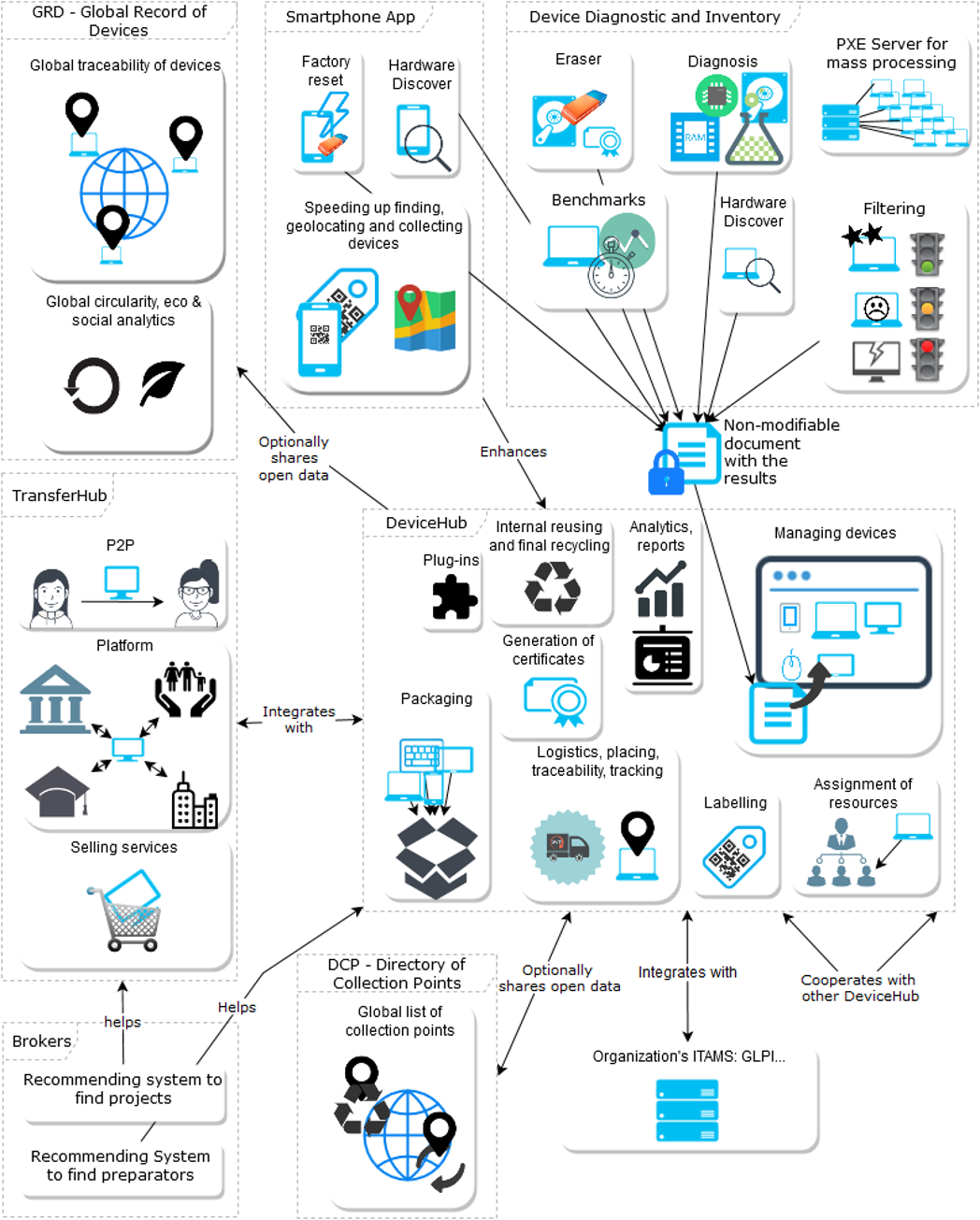
Device Diagnostic and Inventory
Device Inventory is a software to assist the diagnostic and inventory of digital devices (Desktop, Laptop, Netbook and Server). With its self-booting start-up, you don’t have to worry about which operating system is installed. Just boot your device with a CD/USB or network and test your system hardware, capture hardware characteristics for rating and serial number for traceability and reporting. After executing all the desired tools, Device Diagnostic and Inventory generates a signed non-modifiable report with the results of the preparation for reuse process, ensuring that the process is kept totally automatic, and data cannot be modified by a malicious user. If the previous requirements are met, a certificate is issued and the item can be considered reusable (REEE). This report can be uploaded to an compatible ITAMS like DeviceHub.
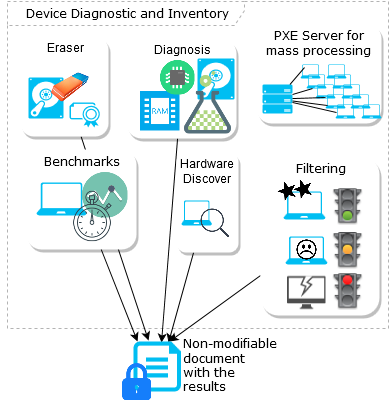
Device Hub
Device Hub is an IT Asset Management System (ITAMS) focused on efficiently managing the circular life-cycle of devices. It allows organizations to manage their hardware more effectively, avoiding unnecessary asset purchases (reduce), promoting the harvesting of existing resources (internal reuse), and interacting with external systems to manage the different processes involved in reusing and recycling, like disposal, external reusing, tracking, etc. These systems can be other ITAMS (like other DeviceHub), other solutions and traceability systems (like the traceability system of eReuse.org, GRD). DeviceHub are federated and autonomous. After the device is in a DeviceHub, the preparer or giver tags the computer by printing its identifier and a QR code that points to the uniform resource locator (URL) where the device description is stored. An example of instantiation of a DeviceHub is the Devicetag.io
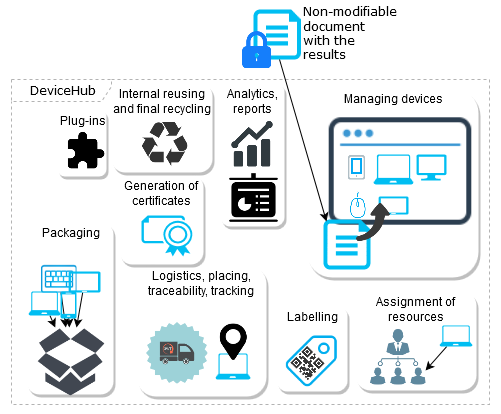
Smartphone App
The eReuse.org App is a smartphone and tablet client for DeviceHub. It is focused in performing certain actions, like geolocating or visualizing devices, that benefit from the portability, camera and geolocalization features of smartphones and tablets; and in registering them to a DeviceHub by using a subset of Device Diagnostic and Inventory functionalities. The main features are: 1) Registering new geolocated places into DeviceHub and assigning devices to them. 2) Quick performing different actions to devices. Some of these actions need geolocation data as they register where they have been performed, as receptions and disposals. 3) Obtaining information about a device scanning a printed QR code. The code is the URL of the device in the DeviceHub where it has been registered.
Global Record of Devices – GRD
Global Record of Devices (GRD) is an online log which maintains a global list of traceability information about devices, so it can assist when there is leakage or similar problems. GRD works with open-data and is designed to be used with external users who want to report traceability information. At the same time, aggregates traceability data with the objective to be used as inputs for indicators measuring circularity indicators. GRD provides a REST API to allow ITAMS, as DeviceHub, to report the life-cycle of devices, environmental responsibilities for organizations, etc. It collects from each device, at least, the geographical paths it has followed (not in detail to preserve privacy), the DeviceHub where it has been stored (the URL), the collection points where it was located before its final recycling and, in the case of computers, the record of its components.
Directory of Collection Points – DCP
To guarantee final recycling of Digital devices the eReuse.org community geo-locate all authorized collection points and ask their users to perform a geo-location action once they send devices to collection for recycle. If last recorded geo-location is has been done within the geographical area of known collection points, we can say with some certainty that the devices have been collected to be recycled.
TransferHub
is a system that manages the distribution channel, focused in simplifying transferals in the reusing process. It announces receivers and givers, so they can find each other easily. Optionally, it can add regulation or transaction mechanisms. TransferHub does not manage the donation itself: it interacts with DeviceHub or similar ITAMS to acknowledge transferences and to retrieve the available devices. TransferHub has three main functionalities: 1) P2P: enables peer to peer transferences, without any regulation scheme. 2) Platform: based on a distributed platform ecosystem that supports donation of devices to excluded collectives and to projects for social change. A Social Platform is an umbrella that federates specific DeviceHubs from donors, receivers and other platforms building an electronic reuse ecosystem. The main features are capturing offer (donations) and demand (social projects), to trade with reuse professional service providers (preparation, installation, maintenance), a donation service (legal advice), a payment system, a social support crowdfunding and a recommendation system. 3) Selling services: adds the necessary to get paid by the transferal, being for example an on-line store.
Newsletter
[:ca]
The eReuse.org platform defines a distributed system, instantiated by multiple organizations and implemented as software services, tools and data repositories.OPEN SOURCE PLATFORM
We present eReuse.org, a set of open-source tools, procedures, open data, and services organised as a common-pool resource (CPR) to reach the circular economy of electronics through promoting reuse and ensuring traceability until recycling.

Device Diagnostic and Inventory
Device Inventory is a software to assist the diagnostic and inventory of digital devices (Desktop, Laptop, Netbook and Server). With its self-booting start-up, you don’t have to worry about which operating system is installed. Just boot your device with a CD/USB or network and test your system hardware, capture hardware characteristics for rating and serial number for traceability and reporting. After executing all the desired tools, Device Diagnostic and Inventory generates a signed non-modifiable report with the results of the preparation for reuse process, ensuring that the process is kept totally automatic, and data cannot be modified by a malicious user. If the previous requirements are met, a certificate is issued and the item can be considered reusable (REEE). This report can be uploaded to an compatible ITAMS like DeviceHub.

Device Hub
Device Hub is an IT Asset Management System (ITAMS) focused on efficiently managing the circular life-cycle of devices. It allows organizations to manage their hardware more effectively, avoiding unnecessary asset purchases (reduce), promoting the harvesting of existing resources (internal reuse), and interacting with external systems to manage the different processes involved in reusing and recycling, like disposal, external reusing, tracking, etc. These systems can be other ITAMS (like other DeviceHub), other solutions and traceability systems (like the traceability system of eReuse.org, GRD). DeviceHub are federated and autonomous. After the device is in a DeviceHub, the preparer or giver tags the computer by printing its identifier and a QR code that points to the uniform resource locator (URL) where the device description is stored. An example of instantiation of a DeviceHub is the Devicetag.io

Smartphone App
The eReuse.org App is a smartphone and tablet client for DeviceHub. It is focused in performing certain actions, like geolocating or visualizing devices, that benefit from the portability, camera and geolocalization features of smartphones and tablets; and in registering them to a DeviceHub by using a subset of Device Diagnostic and Inventory functionalities. The main features are: 1) Registering new geolocated places into DeviceHub and assigning devices to them. 2) Quick performing different actions to devices. Some of these actions need geolocation data as they register where they have been performed, as receptions and disposals. 3) Obtaining information about a device scanning a printed QR code. The code is the URL of the device in the DeviceHub where it has been registered.
Global Record of Devices – GRD
Global Record of Devices (GRD) is an online log which maintains a global list of traceability information about devices, so it can assist when there is leakage or similar problems. GRD works with open-data and is designed to be used with external users who want to report traceability information. At the same time, aggregates traceability data with the objective to be used as inputs for indicators measuring circularity indicators. GRD provides a REST API to allow ITAMS, as DeviceHub, to report the life-cycle of devices, environmental responsibilities for organizations, etc. It collects from each device, at least, the geographical paths it has followed (not in detail to preserve privacy), the DeviceHub where it has been stored (the URL), the collection points where it was located before its final recycling and, in the case of computers, the record of its components.
Directory of Collection Points – DCP
To guarantee final recycling of Digital devices the eReuse.org community geo-locate all authorized collection points and ask their users to perform a geo-location action once they send devices to collection for recycle. If last recorded geo-location is has been done within the geographical area of known collection points, we can say with some certainty that the devices have been collected to be recycled.
TransferHub
is a system that manages the distribution channel, focused in simplifying transferals in the reusing process. It announces receivers and givers, so they can find each other easily. Optionally, it can add regulation or transaction mechanisms. TransferHub does not manage the donation itself: it interacts with DeviceHub or similar ITAMS to acknowledge transferences and to retrieve the available devices. TransferHub has three main functionalities: 1) P2P: enables peer to peer transferences, without any regulation scheme. 2) Platform: based on a distributed platform ecosystem that supports donation of devices to excluded collectives and to projects for social change. A Social Platform is an umbrella that federates specific DeviceHubs from donors, receivers and other platforms building an electronic reuse ecosystem. The main features are capturing offer (donations) and demand (social projects), to trade with reuse professional service providers (preparation, installation, maintenance), a donation service (legal advice), a payment system, a social support crowdfunding and a recommendation system. 3) Selling services: adds the necessary to get paid by the transferal, being for example an on-line store.
Newsletter
[:]
